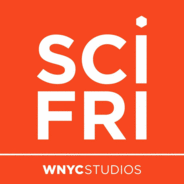Gray wolves are native to the Rocky Mountains, but decades of hunting nearly eradicated them from the western United States by the 1940s. In 1995, wolves were reintroduced to Yellowstone National Park, and it’s been a conservation success story, but not a straight path out of the woods.Host Flora Lichtman digs into the last 30 years of wolves in the West with Heath Druzin, creator of the podcast “Howl,” from Boise State Public Radio and The Idaho Capital Sun. Druzin reported the podcast and companion written series with Clark Corbin.Guest: Heath Druzin is host of the podcast “Howl,” from Boise State Public Radio and The Idaho Capital Sun.Transcripts for each episode are available within 1-3 days at sciencefriday.com.
Subscribe to this podcast. Plus, to stay updated on all things science, sign up for Science Friday's newsletters.

Talk
Science Friday Folgen
Covering the outer reaches of space to the tiniest microbes in our bodies, Science Friday is the source for entertaining and educational stories about science, technology, and other cool stuff.
Folgen von Science Friday
1182 Folgen
-
Folge vom 26.08.2025How Have Gray Wolves Fared 30 Years After Reintroduction?
-
Folge vom 25.08.2025Are Food Dyes Really Bad For You?What do Flamin’ Hot Cheetos, lime Jell-O, and Kraft Creamy French Salad dressing have in common? They've all gotten a glow-up from artificial food dyes. Petroleum-based food dyes have become a target of RFK Jr.’s “Make America Healthy Again” agenda—but what does science say about their effects on health? Joining Host Flora Lichtman to discuss is Asa Bradman, an expert in the health effects of food dyes and other things we’re exposed to in our environment.Guest:Dr. Asa Bradman is a professor of public health at the University of California Merced based in Merced, California.Transcripts for each segment will be available after the show airs on sciencefriday.com.Subscribe to this podcast. Plus, to stay updated on all things science, sign up for Science Friday's newsletters. Subscribe to this podcast. Plus, to stay updated on all things science, sign up for Science Friday's newsletters.
-
Folge vom 22.08.2025mRNA Vaccine For Pancreatic Cancer Continues To Show PromiseThis month, the Department of Health and Human Services terminated almost $500 million in mRNA vaccine development grants and contracts. While HHS has said that these cuts won't affect mRNA cancer research, some researchers have expressed concern about the impact on their ongoing work. In light of these developments, we’re revisiting a conversation from February.A team at Memorial Sloan Kettering is developing an mRNA vaccine for pancreatic cancer, which is notoriously difficult to treat. A few years ago, the team embarked on a small trial to test the vaccine’s safety. Sixteen patients with pancreatic cancer received it, and half of them had a strong immune response. A follow-up study found that in six of those patients, the cancer hadn’t relapsed after three years.Host Flora Lichtman spoke to study author Vinod Balachandran about the work, which has not yet been affected by the cuts, according to Memorial Sloan Kettering.Guest: Dr. Vinod Balachandran is an associate attending surgeon and Director of The Olayan Center for Cancer Vaccines at Memorial Sloan Kettering in New York, New York.Transcripts for each segment will be available after the show airs on sciencefriday.com. Subscribe to this podcast. Plus, to stay updated on all things science, sign up for Science Friday's newsletters.
-
Folge vom 21.08.2025Can The Rise In Solar Power Balance Out Clean Energy Cuts?Since President Trump returned to office, his administration has been aggressive in rolling back clean energy initiatives. But that isn’t the whole story. Texas, California, and other states are bringing so much solar and battery power online that in March, fossil fuels generated less than half the electricity in the US for the first time ever. And internationally, solar has gotten so cheap to build and install that it’s fundamentally transforming many countries’ power grids. So where exactly does solar adoption stand in the US and across the world right now?Climate activist Bill McKibben joins Host Ira Flatow to talk about the recent wins and future challenges that sun-powered energy faces, which he writes about in his new book Here Comes The Sun: A Last Chance for the Climate and a Fresh Chance for Civilization.Guest: Bill McKibben is a climate activist and founder of Third Act. He’s based in Middlebury, Vermont.Transcripts for each episode are available within 1-3 days at sciencefriday.com. Subscribe to this podcast. Plus, to stay updated on all things science, sign up for Science Friday's newsletters.
